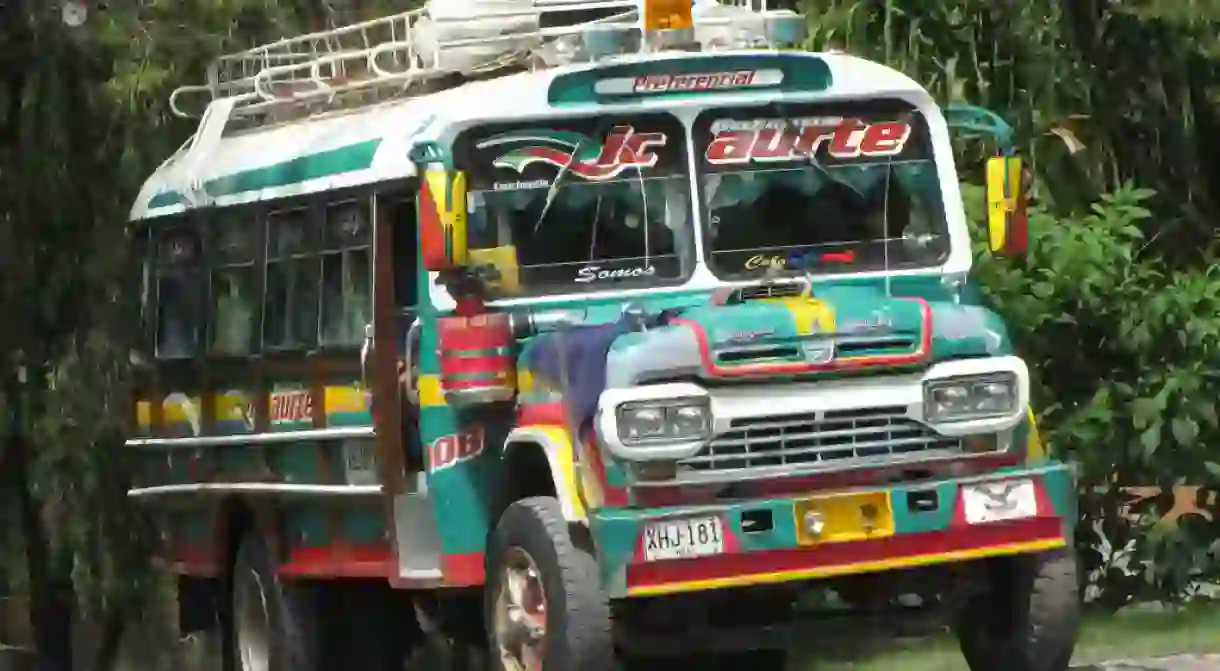The Chiva Bus: From the Colombian Andes to New York City

The brightly colored Chiva bus is a Colombian icon: these hardy buses have been ploughing the mountainous roads of rural Colombia since the beginning of the 20th century, and are recognized as a symbol of Colombian culture. However, in recent years these buses have taken on a new life as raucous urban party buses, and have made the switch from the backroads of the Colombian Andes to the streets of New York City. Here is the story of the Colombian Chiva.
Chiva buses were first introduced in the Colombian department of Antioquia in the early years of the 20th century. The word “chiva” means “goat” in Spanish, a reference to their amazing ability to take on even the toughest Colombian mountain roads. It’s also old Colombian slang for “news” – this references their early role as a means of passing on messages between formerly isolated villages and towns. They are also known colloquially as escalera buses, due to the ladders (escaleras) attached to the back of the bus, allowing people and goods to reach the top for transport purposes.

Prior to the creation of the first Chivas, peasant farmers in Antioquia relied entirely on horse-drawn carts to transport both goods – such as coffee and plantain – and themselves around Colombia’s treacherous mountain roads. In 1908 this began to change when a Colombian engineer named Luciano Restrepo and a Colombian mechanic called Roberto Tisnes imported a bus chassis from the United States and began work on what became the first ever Chiva.
They constructed a body to sit atop the chassis in Medellin, and this makeshift bus first drove between the capital of Antioquia and nearby El Poblado. These original models were far from the rough and ready Chiva buses which plough the winding routes over the mountains nowadays: they sported canvas roofs and simple interiors of four benches. The designers soon added a roof rack, allowing peasants to better transport their goods. The modern Chivas are built upon bus chassis, with modified bodies made of wood or metal, and passengers sit on long wooden benches. They are traditionally painted in bright colors, and often carry the name of the town where they are from.

What surprises many people about Chiva buses is that they remain the principal form of rural transport for many Colombians in Andean departments such as Antioquia, Cauca, and Tolima. Their hardiness and ability to simultaneously transport large amounts of goods and people mean that they have never been improved upon in parts of Colombia that still lack quality roads and which support themselves by producing coffee, potatoes, or plantain. Many tourists are more likely to encounter a Chiva as a small ceramic model in an airport gift shop or Cartagena market stall – these souvenirs, usually painted in the colors of the Colombian flag, serve as a reminder of the special place the Chiva carries in Colombian hearts.
However, Chivas have taken on a life of their own beyond the mountainous roads of the Colombian Andes: they became popular in Colombian cities as converted party buses sometime in the 1960s, and this urban tradition has now transcended its Colombian roots and taken hold globally, particularly in New York City, where a number of Chiva party bus tours now operate.
http://instagram.com/p/BPjHaofgo4Z/?tagged=lachivaloca
In 1986, Carmen Hernandez bought an old school bus in The Bronx and converted it into her first Chiva bus. She was born in Colombia and, after moving to New York, realized it was one part of Colombian culture that she was unable to find in her new home. Starting a Chiva company with her husband and son, Hernandez began with her old converted school bus, and now owns another bus, and employs at least 10 people.
There are now several popular Chiva companies in New York, all offering the quintessential Chiva party experience for a growing crowd of Colombian and Ecuadorian expats – for anywhere between $40 and $150 per hour, passengers are treated to live bands, bar service, food, and stops at Colombian restaurants and nightclubs. The high point for the New York Chiva industry was arguably when actresses Cameron Diaz, Drew Barrymore, and Lucy Liu arrived at the New York premiere of Charlie’s Angels in one of Carmen Hernandez’s Chivas.

The Colombian Chiva bus has come a long way since its humble beginnings as a makeshift means of rural transport in Antioquia. However, the iconic vehicles have managed to bridge the gap between rural and urban Colombia, and have even been embraced beyond their national origins. So, while you can jump on a bouncing party Chiva in Queens, dancing the night away with newfound friends, it is equally possible to pay a few dollars for a seat on a smooth wooden bench to bounce along dirt roads through the beautiful mountains of rural Colombia in a brightly colored bus that represents the heart of a nation.













